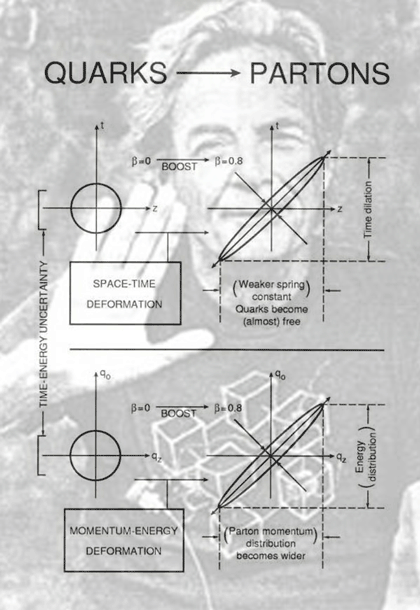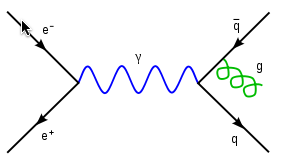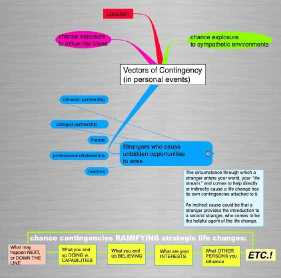
[…] Feynman visualized the world with pictures rather than with equations. Other physicists in the past and present describe the laws of nature with equations and then solve the equations to find out what happens. Feynman skipped the equations and wrote down the solutions directly, using his pictures as a guide. Skipping the equations was his greatest contribution to science. By skipping the equations, he created the language that a majority of modern physicists speak. Incidentally, he created a language that ordinary people without mathematical training can understand. To use the language to do quantitative calculations requires training, but untrained people can use it to describe qualitatively how nature behaves.
Feynman’s picture of the world starts from the idea that the world has two layers, a classical layer and a quantum layer. Classical means that things are ordinary. Quantum means that things are weird. We live in the classical layer. All the things that we can see and touch and measure, such as bricks and people and energies, are classical. We see them with classical devices such as eyes and cameras, and we measure them with classical instruments such as thermometers and clocks. The pictures that Feynman invented to describe the world are classical pictures of objects moving in the classical layer. Each picture represents a possible history of the classical layer. But the real world of atoms and particles is not classical. Atoms and particles appear in Feynman’s pictures as classical objects, but they actually obey quite different laws. They obey the quantum laws that Feynman showed us how to describe by using his pictures. The world of atoms belongs to the quantum layer, which we cannot touch directly.
The primary difference between the classical layer and the quantum layer is that the classical layer deals with facts and the quantum layer deals with probabilities. In situations where classical laws are valid, we can predict the future by observing the past. In situations where quantum laws are valid, we can observe the past but we cannot predict the future. In the quantum layer, events are unpredictable. The Feynman pictures only allow us to calculate the probabilities that various alternative futures may happen.
The quantum layer is related to the classical layer in two ways. First, the state of the quantum layer is what is called “a sum-over-histories,” that is, a combination of every possible history of the classical layer leading up to that state. Each possible classical history is given a quantum amplitude. The quantum amplitude, otherwise known as a wave function, is a number defining the contribution of that classical history to that quantum state. Second, the quantum amplitude is obtained from the picture of that classical history by following a simple set of rules. The rules are pictorial, translating the picture directly into a number. The difficult part of the calculation is to add up the sum-over-histories correctly. The great achievement of Feynman was to show that this sum-over-histories view of the quantum world reproduces all the known results of quantum theory, and allows an exact description of quantum processes in situations where earlier versions of quantum theory had broken down. The ‘Dramatic Picture’ of Richard Feynman New York Review of Books July 14, 2011 Freeman Dyson (reviewing Quantum Man: Richard Feynman’s Life in Science by Lawrence M. Krauss; Feynmana graphical biography by Jim Ottaviani
You see, when you ask why something happens, how does a person answer why something happens?
For example, Aunt Minnie is in the hospital. Why? Because she went out on the ice and slipped and broke her hip. That satisfies people. But it wouldn’t satisfy someone who came from another planet and knew nothing about things… When you explain a why, you have to be in some framework that you’ve allowed something to be true. Otherwise you’re perpetually asking why… You go deeper and deeper in various directions.
Why did she slip on the ice? Well, ice is slippery. Everybody knows that-no problem. But you ask why the ice is slippery… And then you’re involved with something, because there aren’t many things slippery as ice… A solid that’s so slippery?
Because it is in the case of ice that when you stand on it, they say, momentarily the pressure melts the ice a little bit so that you’ve got an instantaneous water surface on which you’re slipping. Why on ice and not on other things? Because water expands when it freezes. So the pressure tries to undo the expansion and melts it…
I’m not answering your question, but I’m telling you how difficult a why question is. You have to know what it is permitted to understand… and what it is you’re not.
You’ll notice in this example that the more I ask why, it gets interesting after a while. That’s my idea, that the deeper a thing is, the more interesting…(Richard Feynman. src: Kallos)
Why was she on the ice in the first place?
Eventually, in my consideration of the analytical frame for constitutive fortuity–eg. transformative anthropology–I’ll be fitting taxonomy to the richer, higher order conceptualization for eventuation. Eventuation means for this purpose the conjunction of events necessary to prime a fortuity. One of the intriguing and hard difficulties in wandering around the current mixture of term and operation is that the informal language used to denote folk conceptions about serendipity, fortuity, inter alia, are weighed down by all sorts of divergent connotations.
For example, Paul Lester describes in his book The Spiral Web a restaurant’s assembly of strangers being there all by coincidence.
OED travels from definition of coincidence, 1 to 4, like this:
1. a.1.a The fact or condition of being coincident; the occupation of the same place or part of space.
4.4 A notable concurrence of events or circumstances having no apparent causal connexion.
The strong connotation in every day use does attach notability, or, the exceptional, or another similar sense, and attaches also an underlying sense of there being no causal connection between two isolate and discretely caused events. This leads the meaning enough so that normal use in English-speaking cultures–for example: what a coincidence!–distinguished between the happenstance circumstance of being in a room full of strangers, and, encountering in this room a stranger, only to find enough of a commonality for the happenstance, to morph into notable coincidence.
However, as much as this leads to semantic, conceptual, and terminological conundrums, it is becoming increasingly clear that the causality that differently situates strangers so him or her come to occupy the same part of space may come to collapse together, as-it-were, in the conjunction given by a fortuitous event.
In which case, the folk phrase what a coincidence stands in for: these disparate events come to eventuate together in a single conjunctive event
This got me to thinking of both the metaphoric semblance, or, analogous collapse of histories. And of Dr. Feynman! With a kind of rubric, or top level category, constitutive fortuity, in hand, the sketching of a structural framework nears.
Something about the Feynman diagram compels me to play around with how elements of such a framework could be depicted.



